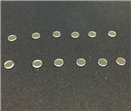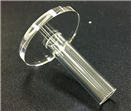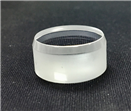

Time:2024-11-13
sapphire crystalIt is mainly composed of aluminum oxide (alumina), with a hexagonal lattice structure and a hardness of Mohs 9. This high hardness gives it excellent wear resistance and scratch resistance, making it an ideal material for manufacturing watch mirrors, mobile phone screen protectors, and optical components. At the same time, it can maintain good stability at high temperatures and has excellent transparency and electrical insulation properties, which together determine its wide application in multiple fields. However, it is precisely these excellent physical properties that pose significant challenges to the mechanical processing of sapphire glass. High hardness means that traditional mechanical processing methods are difficult to effectively carry out, while brittleness can lead to material fracture or surface damage with even a slight carelessness during the processing, increasing processing difficulty and cost.

1、 Processing difficulties
1. The contradiction between high hardness and brittleness
The high hardness of sapphire glass makes it difficult for traditional cutting tools to effectively cut, while brittleness requires strict control of cutting force and speed during the machining process to avoid cracking and edge collapse. This contradiction makes the mechanical processing of sapphire glass a complex system engineering that requires comprehensive consideration of multiple factors, such as tool selection, cutting parameter optimization, machine tool stability, etc.
2. Severe wear and tear of processing tools
Due to the high hardness of sapphire glass, the cutting tools will suffer severe wear during the processing, which not only increases the processing cost but also shortens the service life of the tools. To solve this problem, diamond tools or specially coated tools are usually used for machining, but the cost of these tools is relatively high.
3. Difficulty in precision machining
In the fields of electronics and optoelectronics, the application of sapphire glass often requires high dimensional accuracy. Traditional mechanical processing methods are difficult to meet these requirements and require advanced technologies such as precision grinding, polishing, laser processing, electrochemical processing, and ultrasonic processing. These technologies not only require professional knowledge and experience, but also a deep understanding of the characteristics of sapphire glass.
2、 Existing processing technology
1. Grinding and polishing technology
Grinding and polishing are the main methods for surface processing of sapphire glass, gradually grinding the sapphire glass surface with abrasives of different particle sizes until the desired smoothness and glossiness are achieved. However, this method has problems such as low processing efficiency, high cost, and easy surface scratches. To improve these issues, researchers are exploring more efficient grinding and polishing techniques, such as chemical mechanical polishing (CMP).
2. Precision machining technology
In response to the demand for high-precision processing of sapphire glass, precision processing technologies have emerged, including laser processing, electrochemical processing, ultrasonic processing, etc. Laser processing utilizes the high energy density of laser beams for local heating and melting, achieving material removal; Electrochemical machining removes materials through electrochemical reactions; Ultrasonic processing utilizes the energy generated by ultrasonic vibration to induce fatigue fracture in materials. These technologies each have their own advantages and disadvantages, but they can all meet the precision processing needs of sapphire glass to a certain extent.
The above are the difficulties in sapphire processing. With the advancement of technology and the development of the industry, the processing technology of sapphire glass is constantly innovating and improving. The high hardness and brittleness of sapphire glass pose great challenges to mechanical processing, but also give rise to a series of innovative processing technologies and equipment.






Tel
Mobile phone
Customer service
TOP